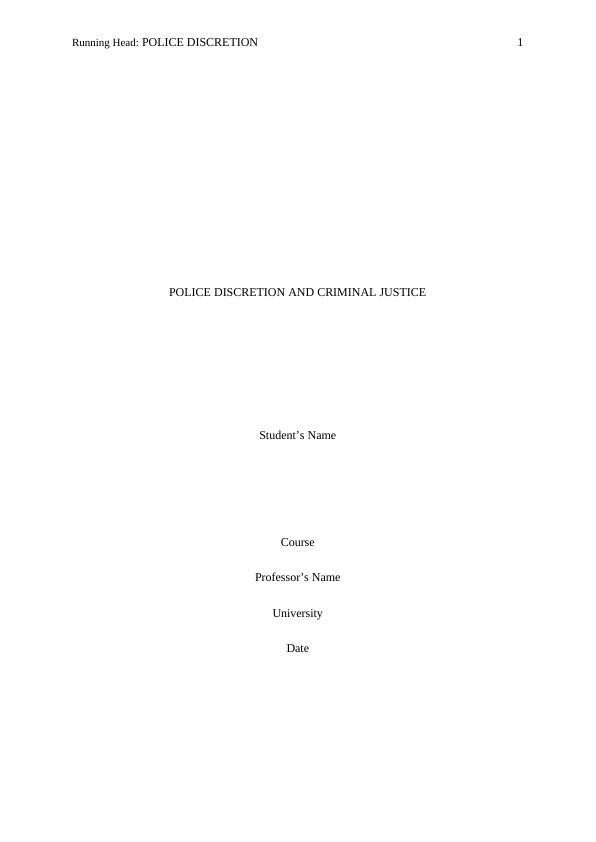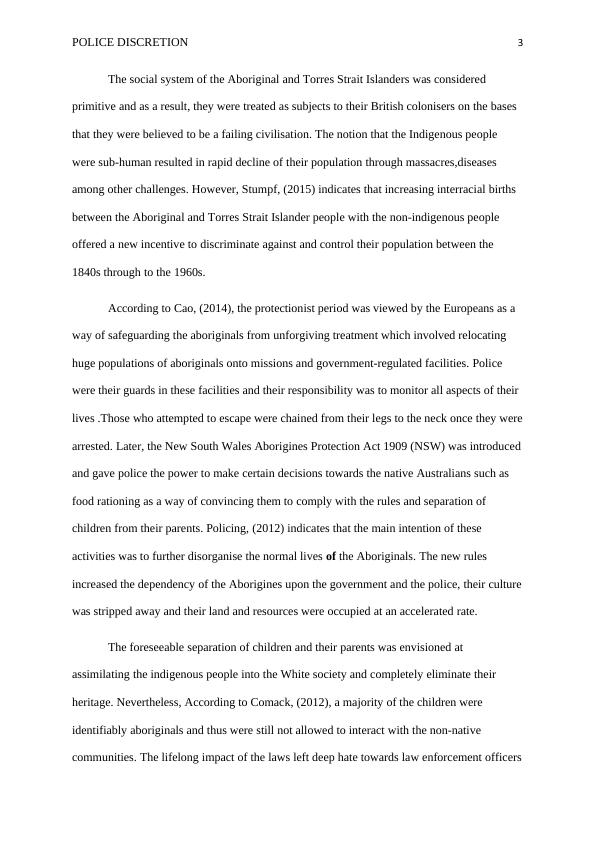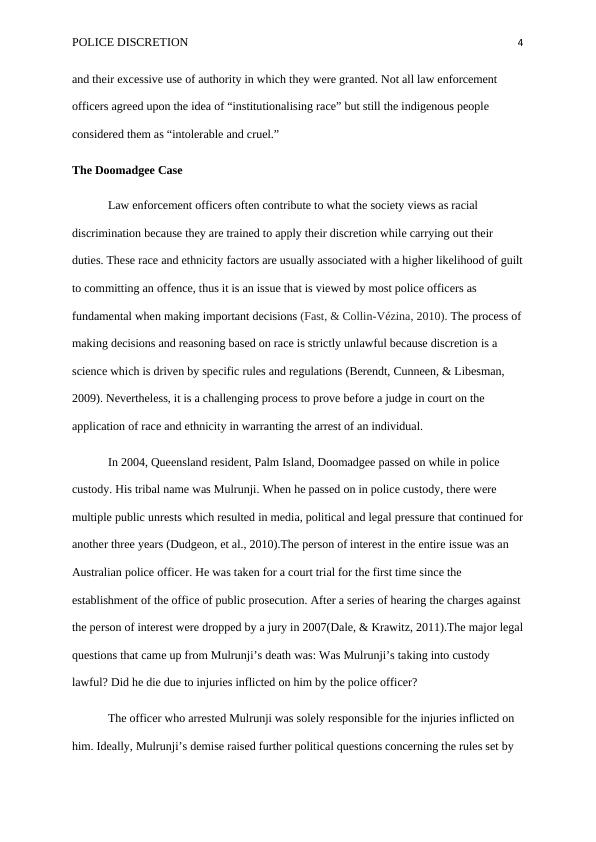Police Discretion and Criminal Justice
Added on 2023-01-13
13 Pages3587 Words51 Views
Running Head: POLICE DISCRETION 1
POLICE DISCRETION AND CRIMINAL JUSTICE
Student’s Name
Course
Professor’s Name
University
Date
POLICE DISCRETION AND CRIMINAL JUSTICE
Student’s Name
Course
Professor’s Name
University
Date

POLICE DISCRETION 2
Introduction
The main objective of this paper is to evaluate police discretion when intermingling
with the Indigenous people. First, we shall review the historical and the contemporary
association between the Indigenous people and the police All through Australia. Further, the
concept of police discretion will be elucidated. Drawing upon this knowledge, this paper will
examine how over policing, and the laws have contributed to the discretionary problem
towards the Aboriginal and Torres Strait Islander people. Lastly, we will discuss the
Doomadgee case in relation to police discretion and how it resulted in the death of Mr.
Mulrunji Doomadgee.
The Association between Law enforcement agency and Indigenous People
The interaction between law enforcement officers and the Aboriginal and Torres
Strait Islander people can only be understood by revisiting the history of the Aboriginal and
Torres Strait Islander peoples in Australia since the arrival of Lt James Cook in 1770. He
made a declaration that the land should be known as New South Wales and this paved way
for the annexation of land by European immigrants in 1788 (Fast, & Collin-Vézina, 2010).
The settlers achieved this through violent massacre to disperse the Indigenous people .As a
result, Many Aboriginals were tortured and killed by settlers who claimed that the land did
not have legal owners. This was followed by dislocation and removal of aboriginals from
their native land and this became their first relationship with the law enforcement agencies.
Their contact with police was hostile and according to Shane, (2010) any resistance was met
with punitive act or even killings by law enforcement officers under the then authoritarian
government acts. Law enforcement officers were utilised as an extension of the British
control, further increasing the mistrust of the Native people.
Introduction
The main objective of this paper is to evaluate police discretion when intermingling
with the Indigenous people. First, we shall review the historical and the contemporary
association between the Indigenous people and the police All through Australia. Further, the
concept of police discretion will be elucidated. Drawing upon this knowledge, this paper will
examine how over policing, and the laws have contributed to the discretionary problem
towards the Aboriginal and Torres Strait Islander people. Lastly, we will discuss the
Doomadgee case in relation to police discretion and how it resulted in the death of Mr.
Mulrunji Doomadgee.
The Association between Law enforcement agency and Indigenous People
The interaction between law enforcement officers and the Aboriginal and Torres
Strait Islander people can only be understood by revisiting the history of the Aboriginal and
Torres Strait Islander peoples in Australia since the arrival of Lt James Cook in 1770. He
made a declaration that the land should be known as New South Wales and this paved way
for the annexation of land by European immigrants in 1788 (Fast, & Collin-Vézina, 2010).
The settlers achieved this through violent massacre to disperse the Indigenous people .As a
result, Many Aboriginals were tortured and killed by settlers who claimed that the land did
not have legal owners. This was followed by dislocation and removal of aboriginals from
their native land and this became their first relationship with the law enforcement agencies.
Their contact with police was hostile and according to Shane, (2010) any resistance was met
with punitive act or even killings by law enforcement officers under the then authoritarian
government acts. Law enforcement officers were utilised as an extension of the British
control, further increasing the mistrust of the Native people.

POLICE DISCRETION 3
The social system of the Aboriginal and Torres Strait Islanders was considered
primitive and as a result, they were treated as subjects to their British colonisers on the bases
that they were believed to be a failing civilisation. The notion that the Indigenous people
were sub-human resulted in rapid decline of their population through massacres,diseases
among other challenges. However, Stumpf, (2015) indicates that increasing interracial births
between the Aboriginal and Torres Strait Islander people with the non-indigenous people
offered a new incentive to discriminate against and control their population between the
1840s through to the 1960s.
According to Cao, (2014), the protectionist period was viewed by the Europeans as a
way of safeguarding the aboriginals from unforgiving treatment which involved relocating
huge populations of aboriginals onto missions and government-regulated facilities. Police
were their guards in these facilities and their responsibility was to monitor all aspects of their
lives .Those who attempted to escape were chained from their legs to the neck once they were
arrested. Later, the New South Wales Aborigines Protection Act 1909 (NSW) was introduced
and gave police the power to make certain decisions towards the native Australians such as
food rationing as a way of convincing them to comply with the rules and separation of
children from their parents. Policing, (2012) indicates that the main intention of these
activities was to further disorganise the normal lives of the Aboriginals. The new rules
increased the dependency of the Aborigines upon the government and the police, their culture
was stripped away and their land and resources were occupied at an accelerated rate.
The foreseeable separation of children and their parents was envisioned at
assimilating the indigenous people into the White society and completely eliminate their
heritage. Nevertheless, According to Comack, (2012), a majority of the children were
identifiably aboriginals and thus were still not allowed to interact with the non-native
communities. The lifelong impact of the laws left deep hate towards law enforcement officers
The social system of the Aboriginal and Torres Strait Islanders was considered
primitive and as a result, they were treated as subjects to their British colonisers on the bases
that they were believed to be a failing civilisation. The notion that the Indigenous people
were sub-human resulted in rapid decline of their population through massacres,diseases
among other challenges. However, Stumpf, (2015) indicates that increasing interracial births
between the Aboriginal and Torres Strait Islander people with the non-indigenous people
offered a new incentive to discriminate against and control their population between the
1840s through to the 1960s.
According to Cao, (2014), the protectionist period was viewed by the Europeans as a
way of safeguarding the aboriginals from unforgiving treatment which involved relocating
huge populations of aboriginals onto missions and government-regulated facilities. Police
were their guards in these facilities and their responsibility was to monitor all aspects of their
lives .Those who attempted to escape were chained from their legs to the neck once they were
arrested. Later, the New South Wales Aborigines Protection Act 1909 (NSW) was introduced
and gave police the power to make certain decisions towards the native Australians such as
food rationing as a way of convincing them to comply with the rules and separation of
children from their parents. Policing, (2012) indicates that the main intention of these
activities was to further disorganise the normal lives of the Aboriginals. The new rules
increased the dependency of the Aborigines upon the government and the police, their culture
was stripped away and their land and resources were occupied at an accelerated rate.
The foreseeable separation of children and their parents was envisioned at
assimilating the indigenous people into the White society and completely eliminate their
heritage. Nevertheless, According to Comack, (2012), a majority of the children were
identifiably aboriginals and thus were still not allowed to interact with the non-native
communities. The lifelong impact of the laws left deep hate towards law enforcement officers

POLICE DISCRETION 4
and their excessive use of authority in which they were granted. Not all law enforcement
officers agreed upon the idea of “institutionalising race” but still the indigenous people
considered them as “intolerable and cruel.”
The Doomadgee Case
Law enforcement officers often contribute to what the society views as racial
discrimination because they are trained to apply their discretion while carrying out their
duties. These race and ethnicity factors are usually associated with a higher likelihood of guilt
to committing an offence, thus it is an issue that is viewed by most police officers as
fundamental when making important decisions (Fast, & Collin-Vézina, 2010). The process of
making decisions and reasoning based on race is strictly unlawful because discretion is a
science which is driven by specific rules and regulations (Berendt, Cunneen, & Libesman,
2009). Nevertheless, it is a challenging process to prove before a judge in court on the
application of race and ethnicity in warranting the arrest of an individual.
In 2004, Queensland resident, Palm Island, Doomadgee passed on while in police
custody. His tribal name was Mulrunji. When he passed on in police custody, there were
multiple public unrests which resulted in media, political and legal pressure that continued for
another three years (Dudgeon, et al., 2010).The person of interest in the entire issue was an
Australian police officer. He was taken for a court trial for the first time since the
establishment of the office of public prosecution. After a series of hearing the charges against
the person of interest were dropped by a jury in 2007(Dale, & Krawitz, 2011).The major legal
questions that came up from Mulrunji’s death was: Was Mulrunji’s taking into custody
lawful? Did he die due to injuries inflicted on him by the police officer?
The officer who arrested Mulrunji was solely responsible for the injuries inflicted on
him. Ideally, Mulrunji’s demise raised further political questions concerning the rules set by
and their excessive use of authority in which they were granted. Not all law enforcement
officers agreed upon the idea of “institutionalising race” but still the indigenous people
considered them as “intolerable and cruel.”
The Doomadgee Case
Law enforcement officers often contribute to what the society views as racial
discrimination because they are trained to apply their discretion while carrying out their
duties. These race and ethnicity factors are usually associated with a higher likelihood of guilt
to committing an offence, thus it is an issue that is viewed by most police officers as
fundamental when making important decisions (Fast, & Collin-Vézina, 2010). The process of
making decisions and reasoning based on race is strictly unlawful because discretion is a
science which is driven by specific rules and regulations (Berendt, Cunneen, & Libesman,
2009). Nevertheless, it is a challenging process to prove before a judge in court on the
application of race and ethnicity in warranting the arrest of an individual.
In 2004, Queensland resident, Palm Island, Doomadgee passed on while in police
custody. His tribal name was Mulrunji. When he passed on in police custody, there were
multiple public unrests which resulted in media, political and legal pressure that continued for
another three years (Dudgeon, et al., 2010).The person of interest in the entire issue was an
Australian police officer. He was taken for a court trial for the first time since the
establishment of the office of public prosecution. After a series of hearing the charges against
the person of interest were dropped by a jury in 2007(Dale, & Krawitz, 2011).The major legal
questions that came up from Mulrunji’s death was: Was Mulrunji’s taking into custody
lawful? Did he die due to injuries inflicted on him by the police officer?
The officer who arrested Mulrunji was solely responsible for the injuries inflicted on
him. Ideally, Mulrunji’s demise raised further political questions concerning the rules set by

End of preview
Want to access all the pages? Upload your documents or become a member.
Related Documents
Communication and Diversity- Introductionlg...
|7
|2103
|139
Indigenous Groups in Australia and Their Historical Traumalg...
|5
|796
|111
Australian Aboriginal Studieslg...
|6
|1112
|39
Indigenous and Non-Indigenous Health Issues in Australialg...
|11
|3054
|415
Culture and History of Koori community Assignment 2022lg...
|6
|1022
|97
Health and Indigenous Australian Peoples Culture Values and Beliefslg...
|8
|2131
|389
